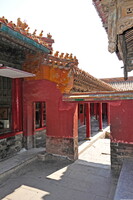| dc.coverage.spatial | Site: Forbidden City (Beijing, Beijing Shi (municipality), China) | en_US |
| dc.coverage.temporal | 1644–1911 (alteration); begun 1421 (creation) | en_US |
| dc.creator | unknown (Chinese) | en_US |
| dc.date | 1421 | en_US |
| dc.date.accessioned | 2013-08-07T18:16:42Z | |
| dc.date.available | 2013-08-07T18:16:42Z | |
| dc.date.issued | 1421 | en_US |
| dc.identifier | 229281 | en_US |
| dc.identifier.other | archrefid: 2351 | en_US |
| dc.identifier.uri | http://hdl.handle.net/1721.3/137065 | |
| dc.description | Connecting structure between the halls, detail roof ridge; The Forbidden City was the Chinese imperial palace from the Ming Dynasty to the end of the Qing Dynasty. The Inner Palace, on the main axis north of the five-bay Gate of Heavenly Purity (Qianqing men), was a more private part of the Forbidden City. When the Yongzheng Emperor ascended to the throne, he did not wish to inhabit the Palace of Heavenly Purity occupied by his father for sixty years. He and subsequent emperors lived instead at the smaller Hall of Mental Cultivation to the west. Originally a minor palace, this became the de facto residence and office of the Emperor starting from Yongzheng. This building is divided into two halls--the front and the rear hall--which are linked by covered corridors and surrounded by side corridors. In the last decades of the Qing Dynasty, empresses dowager, including Cixi, held court from the eastern partition of the hall, the East Warmth Chamber. Located around the Hall of Mental Cultivation are the offices of the Grand Council and other key government bodies. Source: Wikipedia; http://en.wikipedia.org/wiki/Main_Page (accessed 5/11/2011) | en_US |
| dc.format.medium | brick; stucco; tile; painted wood | en_US |
| dc.rights | © Scott Gilchrist, Archivision, Inc. | en_US |
| dc.subject | architecture | en_US |
| dc.subject | decorative arts | en_US |
| dc.subject | historical | en_US |
| dc.subject | rulers and leaders | en_US |
| dc.subject | Chinese | en_US |
| dc.subject | Ming | en_US |
| dc.subject | Qing | en_US |
| dc.title | Forbidden City: Hall of Mental Cultivation (Yang Xin Dian) | en_US |
| dc.title.alternative | Hall of Mental Cultivation (Yangxindian) | en_US |
| dc.type | image | en_US |
| dc.rights.access | Licensed for educational and research use by the MIT community only | en_US |
| dc.identifier.vendorcode | 1A2-CH-B-FC-HMC-A150 | en_US |
| vra.culturalContext | Chinese | en_US |
| vra.technique | carving (processes), construction (assembling), painting and painting techniques | en_US |
| vra.worktype | royal palace | en_US |
| vra.worktype | capital city | en_US |
| vra.worktype | historic site | en_US |
| dc.contributor.display | unknown (Chinese) | en_US |


